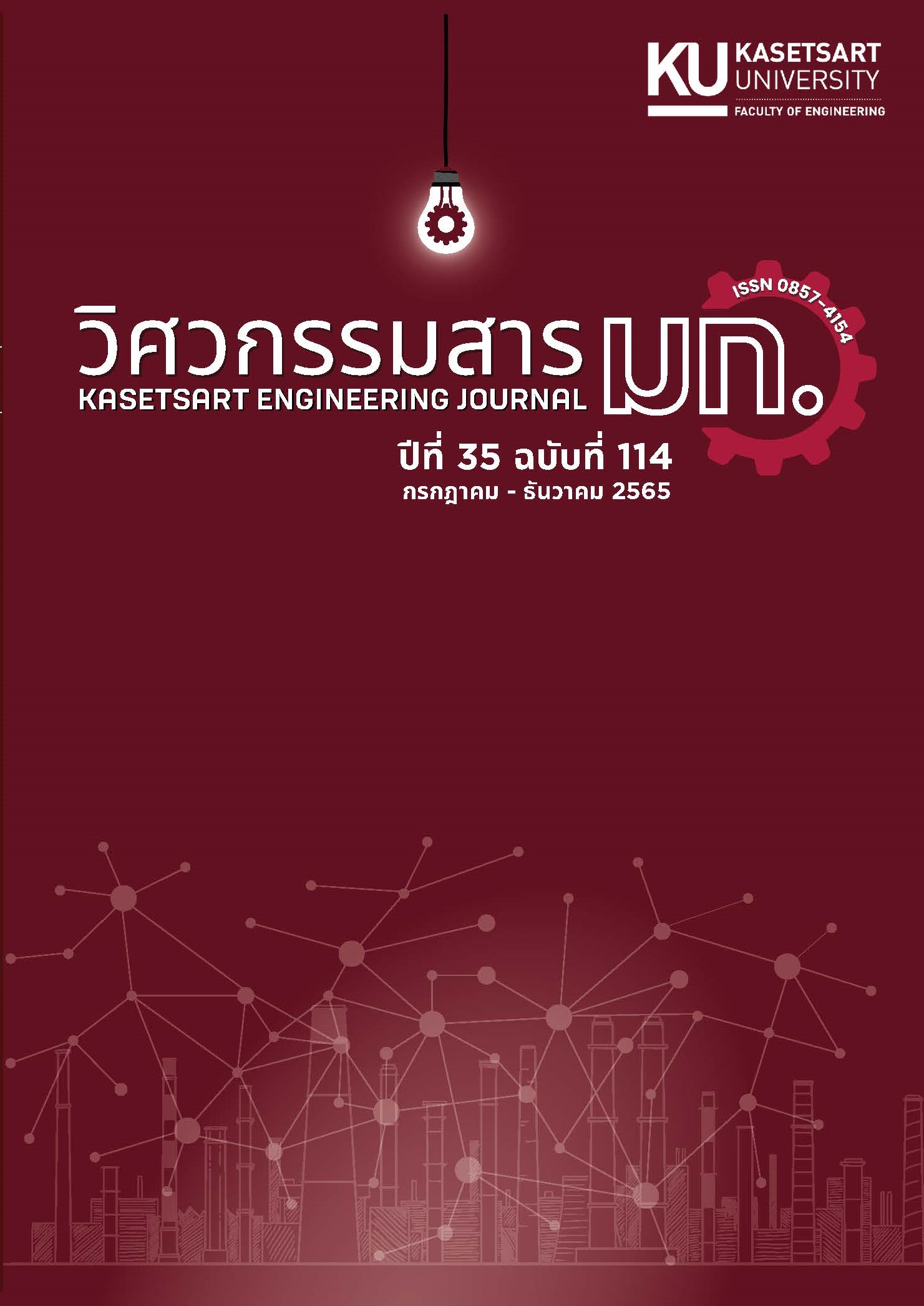การปรับปรุงสมรรถนะของวัสดุไฟเบอร์ซีเมนต์ด้วยสารประกอบอะลูมินัม-สังกะสี
คำสำคัญ:
วัสดุเชิงประกอบ, วัสดุไฟเบอร์ซีเมนต์, สมบัติการกันน้ำ, สารประกอบอะลูมิเนียม, สารประกอบสังกะสีบทคัดย่อ
วัสดุไฟเบอร์ซีเมนต์เป็นวัสดุที่ได้รับความนิยมใช้ในการก่อสร้าง โดยผ่านการขึ้นรูปด้วยเทคโนโลยีขั้นสูง ที่เรียกว่ากระบวนการแฮทเช็ค และการบ่มด้วยความดันไอน้ำสูง หรือการบ่มที่สภาวะปกติ ผลิตภัณฑ์ไฟเบอร์ซีเมนต์ถูกนำไปใช้ในงานที่หลากหลาย ดังนั้นจึงจำเป็นที่จะต้องมีการพัฒนาสมบัติทั้งทางกลและทางกายภาพ อย่างไรก็ตามการยืดหดตัวของผลิตภัณฑ์เนื่องจากความชื้น ส่งผลให้อายุการใช้งานของผลิตภัณฑ์ลดลง งานวิจัยนี้ต้องการพัฒนาผลิตภัณฑ์ไฟเบอร์ซีเมนต์ที่มีสมบัติในด้านการกันน้ำทั่วทั้งผลิตภัณฑ์ โดยใช้สารเติมแต่งชนิดสารประกอบอนินทรีย์ ประเภทสารประกอบสังกะสี และสารประกอบอะลูมิเนียม ชิ้นงานตัวอย่างผ่านการทดสอบสมบัติทางกลโดยเครื่องทดสอบอเนกประสงค์ มีค่ามอดูลัสการแตกหักและค่ามอดูลัสยืดหยุ่น สูงกว่ามาตรฐานอยู่ที่ 9.5 และ 8161 เมกะปาสคาล ตามลำดับ การทดสอบสมบัติทางกายภาพ ได้แก่ การทดสอบค่าความหนาแน่น การดูดซึมน้ำ และการทดสอบมุมสัมผัส พบว่าผลิตภัณฑ์ใหม่ที่ได้มีความหนาแน่นที่สูงขึ้น การดูดซึมน้ำลดลง วัดมุมสัมผัสสูงสุดได้ถึง 133.5 องศา ซึ่งแสดงให้เห็นถึงสมบัติการกันน้ำของผลิตภัณฑ์ อีกทั้งทำการวิเคราะห์ธาตุและองค์ประกอบด้วยกล้องจุลทรรศน์อิเล็กตรอนแบบส่องกราด และเทคนิค Energy Dispersive X-ray Spectroscopy เพื่อตรวจสอบการมีอยู่ของเฟสที่เกิดใหม่ คือ แคลเซียม ไฮดรอกซีซิงค์เซท และเกลือฟิเดล
References
Ling Y F et al. (2020). Effect of Sand Size on Mechanical Performance of Cement-Based Composite Containing PVA Fibers and Nano-SiO(2). Materials (Basel), 13(2).
Shawia N B, M A Jabber, and A F Mamouri (2014). Mechanical and physical properties of natural fiber cement board for building partitions. Physical Sciences Research International, 2(3): 49-53.
Falchi L et al. (2015). The influence of water-repellent admixtures on the behaviour and the effectiveness of Portland limestone cement mortars. Cement and Concrete Composites, 59: 107-118.
Kumar M, M Bansal, and R Garg (2020). An overview of beneficiary aspects of zinc oxide nanoparticles on performance of cement composites. Materials Today: Proceedings, 43.
Šiler P, et al. (2018). The Effect of Zinc on the Portland Cement Hydration. Key Engineering Materials, 761: 131-134.
Dorn T, O Blask, and D Stephan (2022). Acceleration of cement hydration – A review of the working mechanisms, effects on setting time, and compressive strength development of accelerating admixtures. Construction and Building Materials, 323:
Briendl L G, et al. (2020). Early hydration of cementitious systems accelerated by aluminium sulphate: Effect of fine limestone. Cement and Concrete Research, 134: 106069.
Ataie F F, et al. (2015). Comparison of the retarding mechanisms of zinc oxide and sucrose on cement hydration and interactions with supplementary cementitious materials. Cement and Concrete Research, 72: 128-136.
Bartik P, and M Paramita (2022). Understanding Retardation of Cement Hydration Caused by Zinc. ACI Materials Journal, 119(1): 221-232.
Ziegler F, and C A Johnson (2001). The solubility of calcium zincate (CaZn2(OH)6•2H2O). Cement and Concrete Research, 31(9): 1327-1332.
Matejka L, et al. (2021). Negative effect of zinc compounds on hydration kinetics of ordinary Portland cement. IOP Conference Series: Materials Science and Engineering, 1039(1): 012004.
Kim T, et al. (2019). Investigating the Effects of Polyaluminum Chloride on the Properties of Ordinary Portland Cement. Materials (Basel), 12(20).
Ma J, et al. (2015). Synthesis, characterization and formation mechanism of friedel’s salt (FS: 3CaO•Al2O3•CaCl2•10H2O) by the reaction of calcium chloride with sodium aluminate. Journal of Wuhan University of Technology-Mater. Sci. Ed., 30(1): 76-83.
Zhang Z, G Scherer, and A Bauer (2018). Morphology of cementitious material during early hydration. Cement and Concrete Research, 107: 85-100.
Nazari A, and S Riahi (2012). The Effects of ZnO2 Nanoparticles on Strength Assessments and Water Permeability of Concrete in Different Curing Media. Journal of Experimental Nanoscience - J EXP NANOSCI, 14: 1-21.
Tang S, et al. (2023). Influences of Friedel’s Salt Produced by CaO-Activated Titanium-Extracted Tailing Slag on Chloride Binding. Materials, 16, DOI: 10.3390/ma16072843.
Mostafa N, et al. (2009). Hydrothermal synthesis and characterization of aluminium and sulfate substituted 1.1 nm tobermorites. Journal of Alloys and Compounds, 467: 332– 337.
Downloads
เผยแพร่แล้ว
ฉบับ
บท
License

This work is licensed under a Creative Commons Attribution-NonCommercial-NoDerivatives 4.0 International License.

